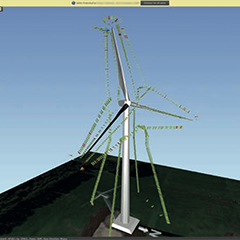Nowadays there is apparently almost no problem that cannot be solved with AI. If cars can even drive completely autonomously, should it not be easy then to find defects and other abnormalities on images from rotor blades of wind-turbines? However, where is the algorithm that detects defects in real time, qualifies them and gives a recommendation for action?
Compared to engineering autonomous vehicles, the problem sounds very simple. Still, it is much more complex than it looks at first glance. The topic of this article is about identifying the difficulties in this business field and what is necessary to overcome these obstacles.
Quality and quantity
Depending on the size, the average surface of the rotor blades on a wind turbine makes up 1000 to 2000 m², which must be inspected visually. In an automated flight, a drone covers this area within just 20 minutes. At Aero Enterprise, the surface is resolved with a median resolution of 20 px/mm². The resulting data record consists of hundreds of images, depending on the dimension of the turbine and the desired image overlap. In one day, for example, inspecting eight turbines with a mean rotor diameter of 135 meters would result in about 8000 pictures. That requires 480 GP (Giga pixels) to be processed and evaluated each day.
This introductory example shows an essential aspect: nowadays, the problem is no longer the quality of the data but it is the quantity. Processing such a volume by hand is almost impossible. That is where AI comes in quite handy.
Is it possible to extract the necessary information out of a given dataset without human interaction?
Digging a little bit deeper and trying to identify the steps and tools, which are necessary to create, develop or train a system that can solve the problem. At the beginning it is necessary to identify and define what we are interested in. The goal is to create high quality training data, which is one of the most important steps.



























